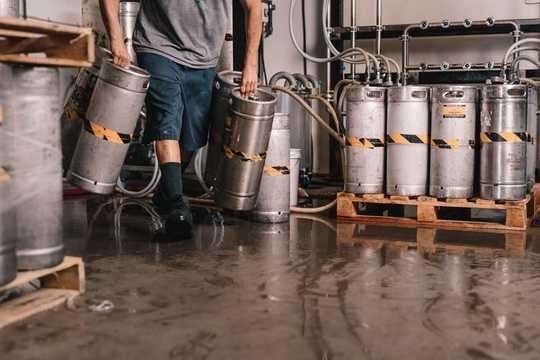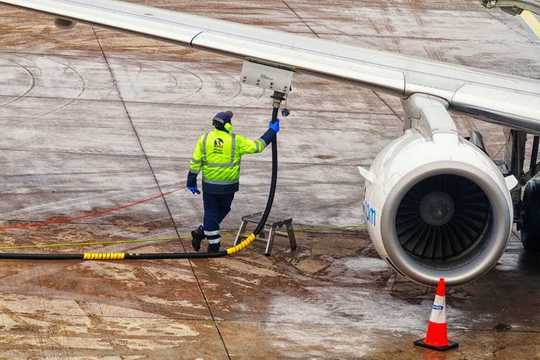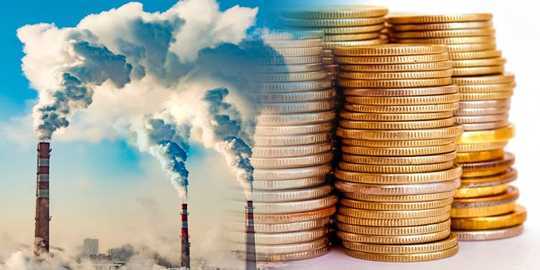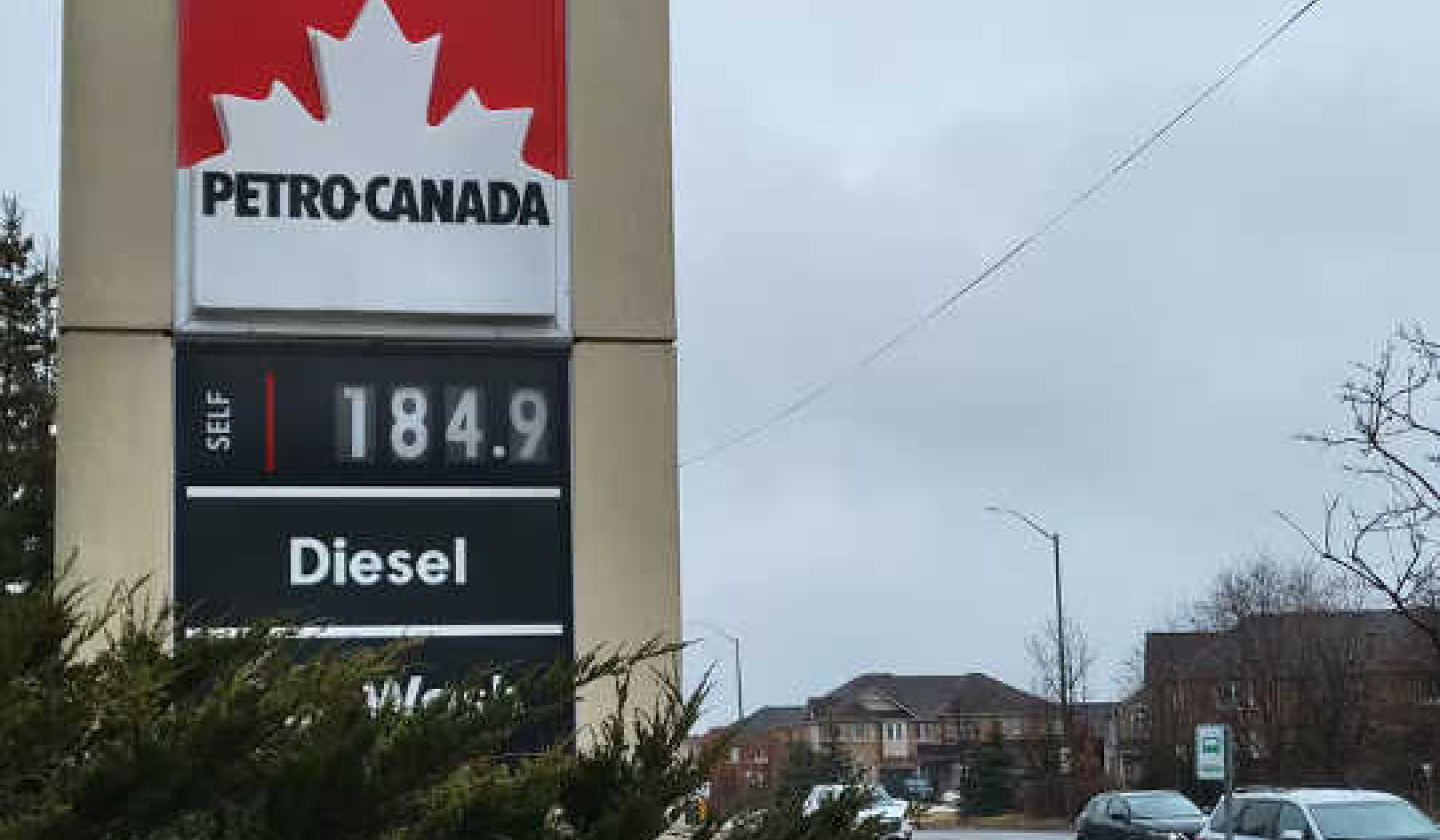It’s far easier to avoid burning fossil fuels than it is to clean up CO? emissions once they’re in the Earth’s atmosphere. But the world no longer has the luxury of choice – drastic emission reductions and rapid CO? removal and storage zote zitahitajika kuzuia athari mbaya zaidi za kupokanzwa kwa ulimwengu.
What if, instead of wasting all that CO?, it could be turned into something useful? There’s currently little economic incentive for industries that emit CO? to capture it, let alone to draw it directly down from the atmosphere. Identifying valuable products and how to make them might kickstart CO? removal on an industrial scale, and help bring down emissions in the process. In karatasi yetu ya hivi karibuni, tuliweka wazi kuelezea ni nini michakato na bidhaa hizi zinaweza kuwa.
We considered processes that use CO? captured from industrial emissions, and also biological processes that can directly draw down CO? from the air. We projected that between one and ten gigatonnes of CO? could be utilised per year by 2050, at costs of under USD$100 (£77) per tonne of CO?. Humans currently emit 37 gigatonnes of CO? a year, and we need to reduce our impact to net zero by around 2050. Some makadirio ya suggest this might mean removing around ten gigatonnes of CO? a year from 2050 onward. Some of these ideas for using CO?, if implemented properly, could play a role in making that more economically viable.
Some ideas for using CO? might not get off the drawing board. But with the right investment and incentives, others may move from niche research projects into credible plans, and from the work of small businesses to the goal of entire industries. Here is a selection of the ways that one person’s pollution could become another’s product.
 Kuunda bidhaa nje ya kaboni kunaweza kusaidia kuanza kuondoa kwake kutoka anga. Kuinua juu ya Unsplash / Shutterstock
Kuunda bidhaa nje ya kaboni kunaweza kusaidia kuanza kuondoa kwake kutoka anga. Kuinua juu ya Unsplash / Shutterstock
1. Tengeneza majengo
There are several ways in which buildings can be constructed with materials made from CO?. The first is obvious: use wood. Growing and sustainably harvesting trees for building means that CO? is taken from the atmosphere, converted into a valuable commercial product, and stored as carbon in long-lived buildings.
Pia inapunguza mahitaji ya saruji, ambayo inawajibika 10-15% ya uzalishaji wa gesi chafu duniani kwa uzalishaji wake. Teknolojia mpya, kama vile miti ya msalaba-iliyochomwa au miti ya asetilini, zinafanya ubadilishaji huu kuwa rahisi kila wakati.
The second way is to use and then store CO? in concrete-making processes, by kuponya saruji au katika kutengeneza ya viungo vingine kama mkusanyiko.
2. Unda bidhaa za plastiki
NINI? inaweza kutumika katika polima kutengeneza plastiki ya kudumu kwa magari na majengo. Karibu 60% ya plastiki ina matumizi katika sekta mbali na ufungaji. Plastics made from CO? could displace bidhaa za plastiki zilizotengenezwa kutoka mafuta ya kinyesi for these sectors, particularly as they don’t require toxic or dirty ingredients such as phosgenes or epoxides, and can be cheaper to make than fossil-fuel based materials. Because the CO? molecule is a stable part of the backbone of the polymer, it can be stored in these materials for as long as they last.
3. Tengeneza mafuta au mbolea
CO? can be used as a feedstock for many chemical processes, with hundreds of potential end products, including hydrocarbon fuels and urea fertilisers.
Fuels made from CO? can exist in the form of methanol as well as more complex products like so-called visanduku. These fuels can often be blended or moved around using existing infrastructure like pipes and tankers. And although CO? fuels are currently very costly to manufacture, in the future they might be valuable in niches like aviation or long-distance shipping, which are ngumu zaidi kuamua kuliko treni na magari kwa sababu zinahitaji mafuta yenye wiani mkubwa wa nishati.
 Wakati itakuwa rahisi kulinganisha na magari na treni kupata umeme, ndege bado zinahitaji mafuta ya kioevu na wiani wa nguvu nyingi kwa muda. Milosz Maslanka / Shutterstock
Wakati itakuwa rahisi kulinganisha na magari na treni kupata umeme, ndege bado zinahitaji mafuta ya kioevu na wiani wa nguvu nyingi kwa muda. Milosz Maslanka / Shutterstock
If the CO? product is a fuel or a fertiliser, the CO? ends up back in the atmosphere once used. While two uses of the carbon is better than one, if the carbon atom originally came from a fossil fuel, it’s not a long-term solution. To be climate neutral, the CO? feedstock will have to be sourced from the air – so the CO? is taken from the atmosphere, made into fuel, and then emitted back to the atmosphere. This is currently expensive and technically challenging. Crucially, the energy required for this process also needs to be renewable.
4. Ongeza mavuno ya mazao
Kuna ushahidi unaoibuka that increasing the amount of carbon in soils can also increase crop yields. This is a natural form of CO? utilisation that already happens – scientists and farmers can just give it a helping hand. One particularly promising way is by using biochar – plant material that has been converted into a stable form of organic carbon via a process known as pyrolysis. Biochar buried in soils could store carbon for the long term and increase crop yields.
Faida za jumla za kujaza na kutunza kaboni kwenye udongo imeundwa vizuri, lakini kutumia udongo kama duka la kaboni ni changamoto kwa sababu inasumbuka kwa urahisi.
5. Futa mafuta zaidi
Counter-intuitively, it’s possible to both produce oil and store CO?. That’s because injecting CO? into an oil well increases the amount of oil that can be recovered – so-called “CO? enhanced oil recovery”.
Inawezekana to operate the well so that more CO? is put into it than is emitted in the process of producing the oil and burning it. But policy changes would be needed to incentivise this – oil companies would not do it otherwise. And it’s a temporary fix. In a world that has fully decarbonised, demand for fossil oil should be close to zero.
Hata hivyo, hii inaweza kuwa njia ya muda mfupi stimulate much needed demand for CO? capture, as emitters could sell their waste CO? to oil producers.
All these options for using CO? have potential, but making them a reality will need a clear understanding of the possible unintended consequences. Many could be failures, so it’d be unwise to rely solely on any one of them, but instead, spread bets widely.![]()
kuhusu Waandishi
Ella Adlen, Meneja wa Utafiti na Programu, Oxford Martin School, Chuo Kikuu cha Oxford na Cameron Hepburn, Profesa wa Uchumi wa Mazingira, Chuo Kikuu cha Oxford
Makala hii imechapishwa tena kutoka Mazungumzo chini ya leseni ya Creative Commons. Soma awali ya makala.
Vitabu kuhusiana
Upungufu: Mpango wa Kisiasa Zaidi Uliopendekezwa Kugeuza Upepo wa Ulimwenguni
na Paul Hawken na Tom Steyer Katika uso wa hofu na upendeleo usioenea, muungano wa kimataifa wa watafiti, wataalamu, na wanasayansi wamekusanyika ili kutoa suluhisho la ufumbuzi wa hali ya hewa na kweli. Mbinu na mazoea mia moja huelezea hapa-baadhi yanajulikana; baadhi huenda haujawahi kusikia. Zinatoka kutoka nishati safi ili kuwaelimisha wasichana katika nchi za kipato cha chini kwa njia za matumizi ya ardhi ambayo huvuta kaboni nje ya hewa. Ufumbuzi unawepo, ni wa kiuchumi unaofaa, na jamii duniani kote sasa huwafanya kwa ustadi na uamuzi. Inapatikana kwenye Amazon
Katika uso wa hofu na upendeleo usioenea, muungano wa kimataifa wa watafiti, wataalamu, na wanasayansi wamekusanyika ili kutoa suluhisho la ufumbuzi wa hali ya hewa na kweli. Mbinu na mazoea mia moja huelezea hapa-baadhi yanajulikana; baadhi huenda haujawahi kusikia. Zinatoka kutoka nishati safi ili kuwaelimisha wasichana katika nchi za kipato cha chini kwa njia za matumizi ya ardhi ambayo huvuta kaboni nje ya hewa. Ufumbuzi unawepo, ni wa kiuchumi unaofaa, na jamii duniani kote sasa huwafanya kwa ustadi na uamuzi. Inapatikana kwenye Amazon
Kuunda Solutions ya Hali ya Hewa: Mwongozo wa Sera kwa Nishati ya Chini ya Carbon
na Hal Harvey, Robbie Orvis, Jeffrey Rissman Pamoja na athari za mabadiliko ya hali ya hewa tayari juu yetu, hitaji la kupunguza uzalishaji wa gesi chafu sio tu chini ya haraka. Ni changamoto kubwa, lakini teknolojia na mikakati ya kuikabili ipo leo. Seti ndogo ya sera za nishati, iliyoundwa na kutekelezwa vizuri, inaweza kutuweka kwenye njia ya maisha ya chini ya kaboni. Mifumo ya nishati ni kubwa na ngumu, kwa hivyo sera ya nishati lazima izingatiwe na gharama nafuu. Mbinu za ukubwa mmoja hazitakamilisha kazi. Watunga sera wanahitaji rasilimali iliyo wazi, kamili inayoelezea sera za nishati ambazo zitakuwa na athari kubwa kwa hali yetu ya hewa ya hali ya hewa, na inaelezea jinsi ya kuunda sera hizi vizuri. Inapatikana kwenye Amazon
Pamoja na athari za mabadiliko ya hali ya hewa tayari juu yetu, hitaji la kupunguza uzalishaji wa gesi chafu sio tu chini ya haraka. Ni changamoto kubwa, lakini teknolojia na mikakati ya kuikabili ipo leo. Seti ndogo ya sera za nishati, iliyoundwa na kutekelezwa vizuri, inaweza kutuweka kwenye njia ya maisha ya chini ya kaboni. Mifumo ya nishati ni kubwa na ngumu, kwa hivyo sera ya nishati lazima izingatiwe na gharama nafuu. Mbinu za ukubwa mmoja hazitakamilisha kazi. Watunga sera wanahitaji rasilimali iliyo wazi, kamili inayoelezea sera za nishati ambazo zitakuwa na athari kubwa kwa hali yetu ya hewa ya hali ya hewa, na inaelezea jinsi ya kuunda sera hizi vizuri. Inapatikana kwenye Amazon
Hii Mabadiliko Kila kitu: Capitalism vs Hali ya Hewa
na Naomi Klein In Hii Mabadiliko Kila kitu Naomi Klein anasema kwamba mabadiliko ya hali ya hewa sio suala jingine tu linalofaa kati ya kodi na huduma za afya. Ni alarm ambayo inatuita sisi kurekebisha mfumo wa kiuchumi ambao tayari hutuvunja kwa njia nyingi. Klein hujenga jinsi ya kupunguza kasi ya uzalishaji wetu wa chafu ni fursa nzuri zaidi kwa wakati huo huo kupunguza kupunguza kutofautiana, kufikiri tena demokrasia zetu zilizovunjika, na kujenga upya uchumi wetu wa ndani. Anafunua kukata tamaa ya kiitikadi ya wasioko wa mabadiliko ya hali ya hewa, udanganyifu wa Kiislamu wa wasiokuwa geoengineers, na kushindwa kwa kutisha kwa mipango mingi ya kijani. Na anaonyesha kwa nini soko haliwezi-na haiwezi kurekebisha mgogoro wa hali ya hewa lakini badala yake hufanya mambo kuwa mabaya zaidi, na njia za uchimbaji wa uharibifu wa mazingira, na uhamasishaji mkubwa wa maafa. Inapatikana kwenye Amazon
In Hii Mabadiliko Kila kitu Naomi Klein anasema kwamba mabadiliko ya hali ya hewa sio suala jingine tu linalofaa kati ya kodi na huduma za afya. Ni alarm ambayo inatuita sisi kurekebisha mfumo wa kiuchumi ambao tayari hutuvunja kwa njia nyingi. Klein hujenga jinsi ya kupunguza kasi ya uzalishaji wetu wa chafu ni fursa nzuri zaidi kwa wakati huo huo kupunguza kupunguza kutofautiana, kufikiri tena demokrasia zetu zilizovunjika, na kujenga upya uchumi wetu wa ndani. Anafunua kukata tamaa ya kiitikadi ya wasioko wa mabadiliko ya hali ya hewa, udanganyifu wa Kiislamu wa wasiokuwa geoengineers, na kushindwa kwa kutisha kwa mipango mingi ya kijani. Na anaonyesha kwa nini soko haliwezi-na haiwezi kurekebisha mgogoro wa hali ya hewa lakini badala yake hufanya mambo kuwa mabaya zaidi, na njia za uchimbaji wa uharibifu wa mazingira, na uhamasishaji mkubwa wa maafa. Inapatikana kwenye Amazon
Kutoka kwa Mchapishaji:
Ununuzi kwenye Amazon huenda ukapoteza gharama ya kukuleta InnerSelf.comelf.com, MightyNatural.com, na Hali ya hewaImpactNews.com bila gharama na bila watangazaji ambao wanafuatilia tabia zako za kuvinjari. Hata kama wewe bonyeza kiungo lakini usiupe bidhaa hizi zilizochaguliwa, kitu kingine chochote unachotumia katika ziara hiyo hiyo kwenye Amazon hutupa tume ndogo. Hakuna gharama ya ziada kwako, kwa hiyo tafadhali shiriki katika jitihada. Unaweza pia tumia kiungo hiki kutumia Amazon wakati wowote ili uweze kusaidia kusaidia jitihada zetu.
























